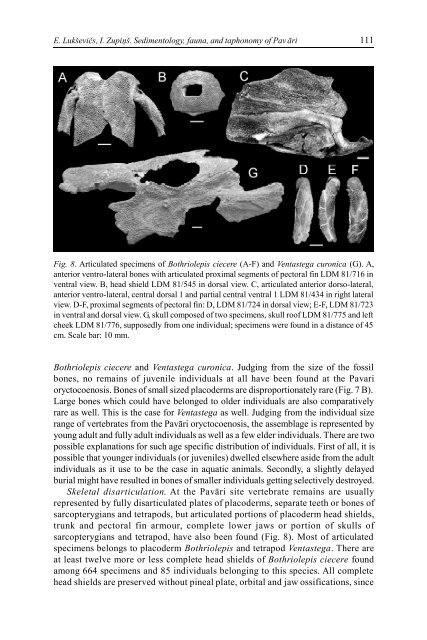Zemes un vides zinātnes Earth and Environment Sciences - Latvijas ...
Zemes un vides zinātnes Earth and Environment Sciences - Latvijas ...
Zemes un vides zinātnes Earth and Environment Sciences - Latvijas ...
Create successful ePaper yourself
Turn your PDF publications into a flip-book with our unique Google optimized e-Paper software.
E. Lukševičs, I. Zupiņš. Sedimentology, fa<strong>un</strong>a, <strong>and</strong> taphonomy of Pav āri<br />
111<br />
Fig. 8. Articulated specimens of Bothriolepis ciecere (A-F) <strong>and</strong> Ventastega curonica (G). A,<br />
anterior ventro-lateral bones with articulated proximal segments of pectoral fin LDM 81/716 in<br />
ventral view. B, head shield LDM 81/545 in dorsal view. C, articulated anterior dorso-lateral,<br />
anterior ventro-lateral, central dorsal 1 <strong>and</strong> partial central ventral 1 LDM 81/434 in right lateral<br />
view. D-F, proximal segments of pectoral fin: D, LDM 81/724 in dorsal view; E-F, LDM 81/723<br />
in ventral <strong>and</strong> dorsal view. G, skull composed of two specimens, skull roof LDM 81/775 <strong>and</strong> left<br />
cheek LDM 81/776, supposedly from one individual; specimens were fo<strong>un</strong>d in a distance of 45<br />
cm. Scale bar: 10 mm.<br />
Bothriolepis ciecere <strong>and</strong> Ventastega curonica. Judging from the size of the fossil<br />
bones, no remains of juvenile individuals at all have been fo<strong>un</strong>d at the Pavari<br />
oryctocoenosis. Bones of small sized placoderms are disproportionately rare (Fig. 7 B).<br />
Large bones which could have belonged to older individuals are also comparatively<br />
rare as well. This is the case for Ventastega as well. Judging from the individual size<br />
range of vertebrates from the Pavāri oryctocoenosis, the assemblage is represented by<br />
yo<strong>un</strong>g adult <strong>and</strong> fully adult individuals as well as a few elder individuals. There are two<br />
possible explanations for such age specific distribution of individuals. First of all, it is<br />
possible that yo<strong>un</strong>ger individuals (or juveniles) dwelled elsewhere aside from the adult<br />
individuals as it use to be the case in aquatic animals. Secondly, a slightly delayed<br />
burial might have resulted in bones of smaller individuals getting selectively destroyed.<br />
Skeletal disarticulation. At the Pavāri site vertebrate remains are usually<br />
represented by fully disarticulated plates of placoderms, separate teeth or bones of<br />
sarcopterygians <strong>and</strong> tetrapods, but articulated portions of placoderm head shields,<br />
tr<strong>un</strong>k <strong>and</strong> pectoral fin armour, complete lower jaws or portion of skulls of<br />
sarcopterygians <strong>and</strong> tetrapod, have also been fo<strong>un</strong>d (Fig. 8). Most of articulated<br />
specimens belongs to placoderm Bothriolepis <strong>and</strong> tetrapod Ventastega. There are<br />
at least twelve more or less complete head shields of Bothriolepis ciecere fo<strong>un</strong>d<br />
among 664 specimens <strong>and</strong> 85 individuals belonging to this species. All complete<br />
head shields are preserved without pineal plate, orbital <strong>and</strong> jaw ossifications, since
















